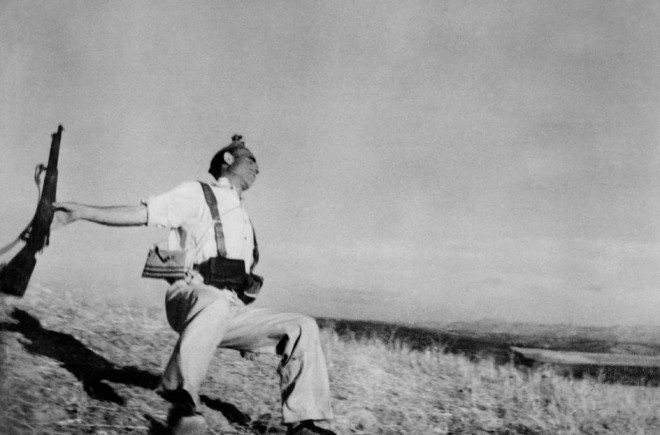Hey streettogs, I’m starting a new book on a distillation of all the “Learn from the Masters” articles I’ve written. I hope these daily lessons can inspire you, I know they inspired me!
—

“If your photographs aren’t good enough, you’re not close enough.” – Robert Capa
One of the common mistakes that many beginning street photographers make is this: they don’t get close enough.
We have many fears and provide a lot of excuses for not getting close enough in our street photography. We are worried about pissing people off, we are worried about making other people feel uncomfortable, and we are worried that strangers might call the cops on us (or even worse, physically assault us).
However realize that this is all in your head. By getting closer to a stranger, you won’t die. In-fact, I have learned that in photography (and life), with physical proximity comes emotional proximity.
It isn’t enough to use a telephoto or zoom lens to get “close” to your subject. That is fake intimacy. By using a telephoto lens, you are treating your subjects like zoo animals, and your photography is a safari hunt.
However when we read the quote from Robert Capa on closeness, it doesn’t necessarily mean physical proximity. You can be physically close to your subject, and still emotionally distant. The most important thing as a street photographer is to empathize with your subject and try to connect with them, their emotions, feelings, and condition.
In street photography I generally recommend using a 35mm lens (full-frame equivalent) for most photographers (Alex Webb, Constantine Manos, and Anders Petersen shoot with this focal length). The human eye sees the world in around a 40mm field-of-view, and I find that shooting with a 35mm lens gives you enough wiggle-room around the edges of the frame.
A 50mm is fine too (Henri Cartier-Bresson was famous for using it for nearly his entire life), but in today’s crowded world, I find it to be a bit too tight. A 28mm is fantastic too (William Klein, Bruce Gilden, and Garry Winogrand have used this focal length), but realize that you have to be close enough with this lens to fill the frame.
As a rule-of-thumb, I try to shoot with a 35mm at least two-arm-lengths away (or closer). 2 arm-lengths is 1.2 meters (around 4 feet). Therefore I always have my camera pre-focused to 1.2 meters, set at f/8, ISO 1600, and I simply go out to find moments to shoot.
The .7 Meter Challenge
To truly get comfortable getting closer to your subjects, try this assignment from my friend Satoki Nagata: For an entire month, only take photos of your subjects from .7 meters (1-arm-length). For this assignment, switch your camera to manual-focusing mode, and tape the focusing mechanism of your lens to that distance. By setting yourself this “creative constraint,” you will learn how to better engage your subjects and get them comfortable with you shooting at such a close distance.
Start off by asking for permission, then once you feel more courageous, start shooting candidly.
You can read more on the .7 meter challenge here.
Shooting street photography with a telephoto
You don’t always need to shoot with a wide angle lens. Some of the greatest street photographers have used a longer lens, such as Saul Leiter, Tony Ray Jones, and Rene Burri. They used long lenses intentionally to compress their backgrounds and make unique images. However their images still have emotion and soul to them, as they caught moments of the “human condition.”
Ultimately use the lens and focal length which suits your personality. But if you’ve never tried shooting wide and getting physically close in street photography, I recommend you to try it out, and push yourself out of your comfort zone.


